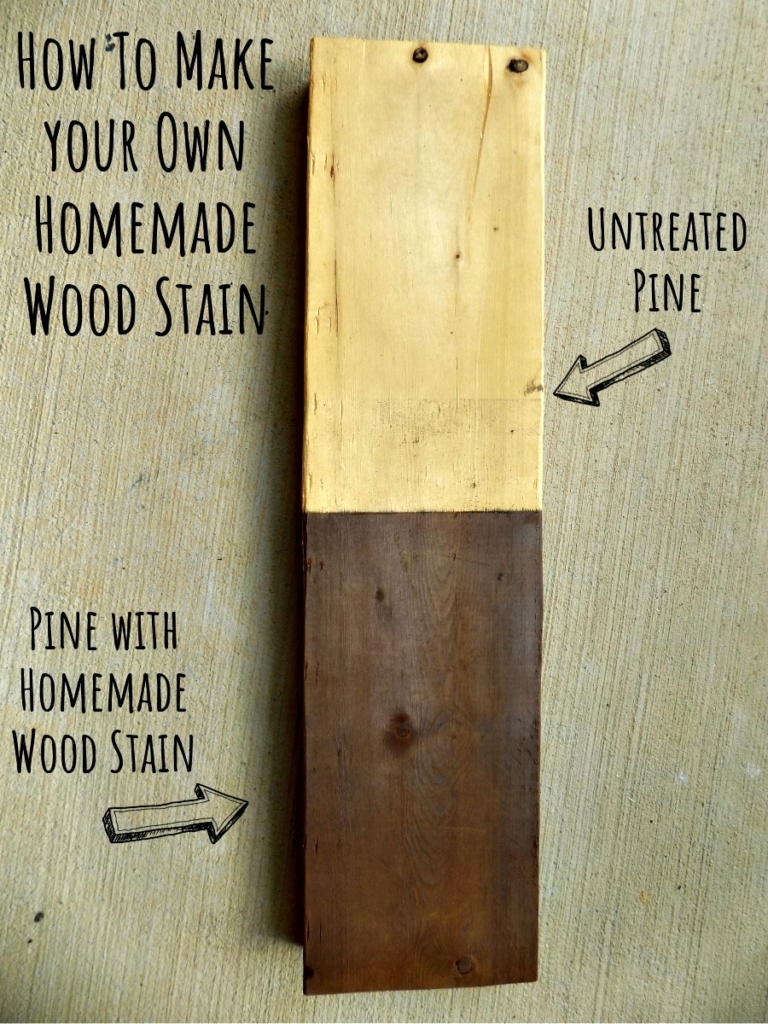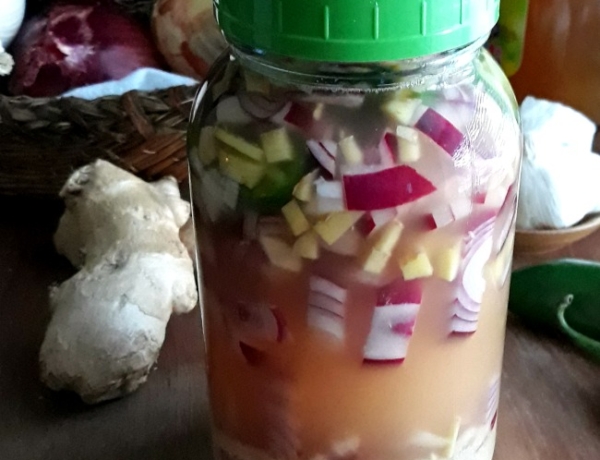We are a household of makers. That is to say, we do a lot of DIY and crafts around here. And while I have a general love of all things making and crafting, my husband’s passion is for woodworking – the result of this partnership being that we have a whole lot of handmade and upcycled decor and furniture. And although my husband mainly does all the building stuff, my domain is usually the painting, staining, and finishing (or refinishing when it comes to freshening up vintage finds).

Some years ago, I stumbled upon the concept of an old-fashioned, homemade wood stain. I tried it once and fell in love. I now use it for many of my furniture projects and for good reasons. It’s super-convenient, and ridiculously cheap, being made with a couple of ingredients you probably have laying around the house right now (vinegar, steel wool, and tea and/or coffee). It’s also not as noxious as a commercially-made stain (I know that commercial wood stain has its place, and I do still use it on occasion, but I like to use something on the less toxic side when I can). And let’s not forget that this stain is beautiful. I can use it to get the rustic, aged look that I love.
The possible downside of this stain is that it’s a “Your Mileage May Vary” kind of thing, and an art as much as a science. It’s not really consistent from batch to batch, and the color will be different based on the ratios of ingredients, the type of wood, and also the types of vinegar, tea, or coffee used. When starting a new project, I like to experiment on a scrap piece of wood to make sure I have the color that I want. This stain also takes a few days to make, and you’ll want to make sure you prepare a big enough batch to complete your project in one go (or run the risk of not getting the same color in the second batch.)
I think it’s important to understand a little about how this stain works so that you can achieve the shades you want. It’s all down to chemical reactions. First, the steel wool reacts with the vinegar, creating iron acetate which creates a reddish or “rusty” color. The longer the steel wool sits in the vinegar, the stronger this solution becomes. The iron acetate then reacts with the tannins in the tea and/or coffee to create a darker, greyer color. (There are also naturally-occurring tannins in wood, the amount of which will be different depending on the type of wood – this is why a test scrap of wood is so important). This process of staining is sometimes known as “ebonizing” because if you get enough tannins reacting, you can actually stain the wood a deep black ebony color.
Here is the basic recipe I use to make a rich, chocolatey color stain. For this recipe, I use apple cider vinegar, but you can use any kind of vinegar, and any type of coffee or tea – experiment and see what you like. If you want a lighter, greyer color with less red tones, allow the vinegar and steel wool to sit for only 1-2 days before straining.
1 pint of apple cider vinegar
1 pad of steel wool (use the kind without soap, or thoroughly rinse out any soap)
¼ cup brewed coffee (optional- it just gives extra tannins)
1 pint strong brewed black tea
Place the steel wool in a pint jar, and cover with apple cider vinegar. Cover with plastic wrap, and poke a few holes in the plastic wrap to allow gases to escape. I usually put it on my porch because of the vinegar smell. Every day, agitate the jar a little just to stir things up.
After 7 days, the steel wool will be falling apart, and the color will be very dark and muddy. Strain through a coffee filter into a clean glass jar. At this point, add in the brewed coffee. Use a foam brush or a rag to wipe the mixture all over your wood. The wood will start showing its stain within a few minutes, but I find the color often continues to develop for up to a day.
The final step is to apply the brewed tea. Because I like to see how the color changes between steps, I usually allow the iron acetate-stained wood to develop for a few hours before I proceed with the tea. There is no harm, however, in applying the tea immediately following the iron acetate.
After applying the tea, allow to completely dry for a day or two. If you want to darken the stain further, apply another coat of tea. When completely dry, apply the top coat of your choice.
Now here is where I give a disclaimer and a little word of caution. I am not a chemist. Although this is a relatively “natural” stain made from household ingredients, it is still made of “chemicals”, as are all things, even in nature. It will stain your hands and clothes, so definitely wear gloves. Use proper ventilation because, although it doesn’t smell like commercial wood stain, it is still a bit stinky. And definitely don’t go around drinking the stuff, for goodness sakes. And please don’t experiment by adding other chemicals, unless you know what you’re doing. Let’s treat it as a household chemical and give it the respect it deserves.
Ok, so that’s it – so easy to make a homemade wood stain! I hope you give it a try!
-Melissa




No Comments